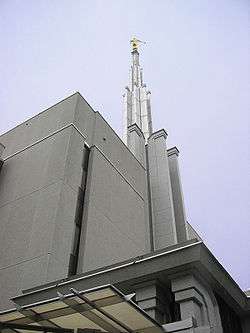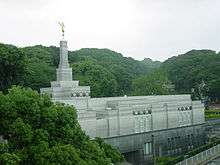The Church of Jesus Christ of Latter-day Saints in Japan

The Church of Jesus Christ of Latter-day Saints (LDS Church) (Japanese: 末日聖徒イエス・キリスト教会) was established in Japan in 1901[1] when the first LDS Church missionaries arrived on August 12, 1901. Among them was Heber J. Grant, at the time a member of the Quorum of the Twelve, the 7th President of the Church.[2] Accompanying Grant was Horace S. Ensign, Louis A. Kelsch and Alma O. Taylor. The first baptism was on March 8, 1902, when Grant baptized Hajime Nakazawa, a former Kannushi (Shinto priest).
Membership
As of July 2016, the LDS Church reported 128,216 members,.[3] As of April 2013, there were 29 stakes, 13 districts, 164 wards, 117 branches, 7 mission, and 2 temples in Japan.
History
In 1901, Heber J. Grant established the first LDS Church mission in Asia, headquartered in Tokyo.[2] This was the first mission established in Asia.[1][4]:168 However, on August 7, 1924, Grant, then president of the church, closed the mission to await a more "favorable time".[1][5] All missionaries then left for the United States. Fujiya Nara, a Japanese convert, was appointed presiding elder by the First Presidency over the small group of Japanese members that remained. Nara published a newsletter, "Shuro" (Palm) and held meetings with the remaining members.
On February 24, 1937 the Japanese-Central Pacific Mission, a mission aimed at teaching primarily Japanese people in Hawaii, was opened, headquarters in Honolulu, Hawaii, with Hilton A. Robertson as president. However, it was not until March 6, 1948, that then mission president Edward L. Clissold was given permission to return to Japan to do missionary work.
Clissold had been part of the United States military occupation forces in Japan after World War II. While there he ran an advertisement seeking out members of the LDS Church who had been baptized prior to the missionaries leaving in 1924. He was able to find some, including Fujiya Nara, and reestablish the Church there.[6] Prior to this from 1943 to 1944 Clissold had been acting president of the Central Pacific Mission, a mission in Hawaii that was aimed at teaching primarily Japanese people. The first five missionaries arrived in Japan on June 26, 1948.
On April 26, 1964, the first meetinghouse in Asia, the Tokyo North Branch, was dedicated by Gordon B. Hinckley, then a member of the Quorum of the Twelve Apostles.[1][7] The Tokyo Stake was the first stake of the church in Asia, organized on March 15, 1970.[1] Within the same week the church opened a display at Expo '70 in Osaka, featuring a new version of Man's Search for Happiness, created specially for this event.[8] BYU's Young Ambassadors, also performed at the expo.[9] The first LDS temple in Asia was the Tokyo Temple, dedicated in 1980.[1] In 1965 Adney Y. Komatsu was called as a mission president, the first of Japanese ancestry, and in 1975 he became the first general authority of Japanese (and Asian) ancestry.[1] Yoshihiko Kikuchi was the first native Japanese general authority, called in 1977.[1]
Missions
As of March 15, 2011, there were over 630 missionaries serving in the church's six missions in Japan.[10]
- Japan Fukuoka Mission
- Japan Kobe Mission
- Japan Nagoya Mission
- Japan Sapporo Mission
- Japan Sendai Mission
- Japan Tokyo Mission
- Japan Tokyo South Mission (re-created July 2013).[11]
Slang
Missionaries in Japan often use a specific type of slang called senkyoshigo[12] when communicating with each other. This "mission language" has been used nearly universally in the missions of Japan. It is distinct from but combines aspects of the English and Japanese languages.[13] Some words and expressions are mission- or language-specific, while others are common with non-Japanese missions, such as calling the halfway point of a mission the "hump" or hump day,[14] or describing a missionary who is excited about returning home as "trunky" as he has already packed his trunk.[13]
Temples
On October 27, 1980, the Tokyo Japan Temple (formerly the Tokyo Temple) (東京神殿 Tōkyō Shinden) was dedicated. This was the first temple in Asia and the first in a non-Christian country, for the LDS Church. President Spencer W. Kimball described it as "the most significant and important event in the history of Asia."[15]
The Tokyo Temple was followed by the Fukuoka Japan Temple (福岡神殿 Fukuoka Shinden), dedicated on June 11, 2000 and the Sapporo Japan Temple (札幌神殿 Sapporo Shinden), under construction as of 22 October 22, 2011
|
|
18. Tokyo Japan | ||
|
Location: |
Tokyo, Japan | ||
|
|
88. Fukuoka Japan | ||
|
Location: |
Fukuoka, Japan | ||
|
|
151. Sapporo Japan | ||
|
Location: |
Sapporo, Japan | ||
See also
- Christianity in Japan
- Yanagida Toshiko
- Bernard P. Brockbank
- Yuki Saito[19]
- Yukihiro Matsumoto[20]
- Kent Derricott
- Kent Gilbert
References
- 1 2 3 4 5 6 7 8 "Country information: Japan", Church News Online Almanac, LDS Church News, January 29, 2010, retrieved 2014-10-15
- 1 2 Grant, Heber J. (2002). "The Life and Ministry of Heber J. Grant". Teachings of Presidents of the Church: Heber J. Grant. LDS Church. LCCN 2004268057. OCLC 54500103.
- ↑ "Facts and Statistics: Japan". The Church of Jesus Christ of Latter-day Saints. Archived from the original on July 12, 2016. Retrieved July 12, 2016.
- ↑ Hinckley, Gordon B. (March 1964), "The Church in the Orient", Improvement Era, 67 (3): 166–193
- ↑ Britsch, R. Lanier (Winter 1975), "The Closing of the Early Japan Mission", BYU Studies, 15 (2): 171–190
- ↑ Yukiko, Konno (April 1993). "Fujiya Nara: Twice a Pioneer". Ensign.
- ↑ "Upsurge reported in new chapels in Orient", LDS Church News, p. 12, April 18, 1964, retrieved 2014-10-15
- ↑ "LDS Display Draws Throngs at Expo '70", Deseret News, pp. B1, B2, March 16, 1970
- ↑ "BYU Entertainers Leave for Expo '70 In Japan", Deseret News, p. B5, March 16, 1970
- ↑ Taylor, Scott (March 15, 2011). "LDS Church in Japan: Moving missionaries, making donations". Deseret News. Salt Lake City, Utah. Retrieved 2014-10-15.
- ↑ "New mission presidents by area for 2013", LDS Church News, March 5, 2013, retrieved 2014-10-05
- ↑ This literally translates as: senkyoshi → missionary; go → language (Smout 1988).
- 1 2 Smout, Kary D. (Summer 1988). "Senkyoshigo: A Missionary English of Japan". American Speech. 63 (2): 137–149. doi:10.2307/454418. JSTOR 454418.
- ↑ Skousen, Paul B. (2005). Brother Paul's Mormon Bathroom Reader. Cedar Fort. p. 359. ISBN 1-55517-895-2. OCLC 62676136.
- ↑ "This week in Church history", Church News, October 22, 2005
- ↑ "President Thomas S. Monson: 'Welcome to Conference'", Deseret News, October 3, 2009, retrieved 2012-11-06.
- ↑ Talor, Scott (October 4, 2009), "Brigham City among five new locales for LDS temples", Deseret News, retrieved 2012-11-06.
- ↑ "Groundbreaking Held For Sapporo Japan Temple", MormonNewsroom.org (News Release), LDS Church, October 22, 2011, retrieved 2014-10-15.
- ↑ "Yuki Saito". LDS Films. Retrieved July 25, 2006.
- ↑ Hi I'm まつもとゆきひろ (Matsumoto "Matz" Yukihiro). I am a computer programmer. I designed a programming language called ‘Ruby.’ I am a Mormon. http://www.mormon.org/matz (Japanese)
Further reading
- Britsch, Ralph Lanier (1968), Early Latter-Day Saint Missions to South and East Asia (Thesis), Claremont Graduate School and University Center, OCLC 39674131, retrieved 2014-10-05
- Britsch, Ralph Lanier (1992), "Asia, the Church in", in Ludlow, Daniel H, Encyclopedia of Mormonism, New York: Macmillan Publishing, pp. 75–81, ISBN 0-02-879602-0, OCLC 24502140
- Britsch, Ralph Lanier (1998), From the East: The History of the Latter-Day Saints in Asia, 1851-1996, Salt Lake City, Utah: Deseret Book, ISBN 1573452688, LCCN 97036785, OCLC 37606249
- Clark, Drew (13 July 2014), "Samurai visiting Salt Lake in 1872 launched interactions between Japanese and Mormons", Deseret News
External links
- Official website (Japanese)



